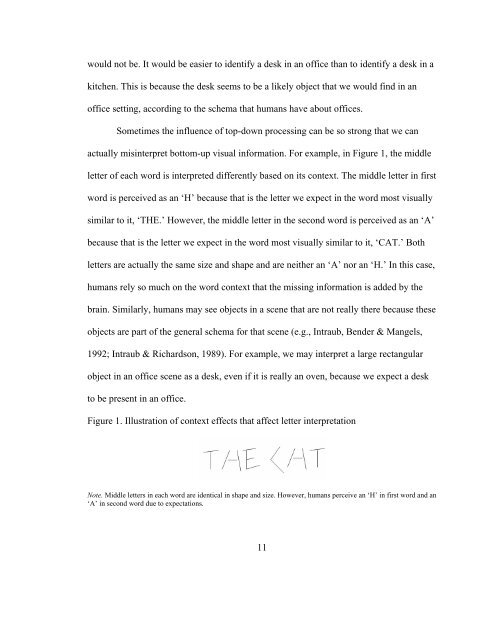The Use of Iambic Pentameter in the
The Use of Iambic Pentameter in the
The Use of Iambic Pentameter in the
You also want an ePaper? Increase the reach of your titles
YUMPU automatically turns print PDFs into web optimized ePapers that Google loves.
would not be. It would be easier to identify a desk <strong>in</strong> an <strong>of</strong>fice than to identify a desk <strong>in</strong> a<br />
kitchen. This is because <strong>the</strong> desk seems to be a likely object that we would f<strong>in</strong>d <strong>in</strong> an<br />
<strong>of</strong>fice sett<strong>in</strong>g, accord<strong>in</strong>g to <strong>the</strong> schema that humans have about <strong>of</strong>fices.<br />
Sometimes <strong>the</strong> <strong>in</strong>fluence <strong>of</strong> top-down process<strong>in</strong>g can be so strong that we can<br />
actually mis<strong>in</strong>terpret bottom-up visual <strong>in</strong>formation. For example, <strong>in</strong> Figure 1, <strong>the</strong> middle<br />
letter <strong>of</strong> each word is <strong>in</strong>terpreted differently based on its context. <strong>The</strong> middle letter <strong>in</strong> first<br />
word is perceived as an ‘H’ because that is <strong>the</strong> letter we expect <strong>in</strong> <strong>the</strong> word most visually<br />
similar to it, ‘THE.’ However, <strong>the</strong> middle letter <strong>in</strong> <strong>the</strong> second word is perceived as an ‘A’<br />
because that is <strong>the</strong> letter we expect <strong>in</strong> <strong>the</strong> word most visually similar to it, ‘CAT.’ Both<br />
letters are actually <strong>the</strong> same size and shape and are nei<strong>the</strong>r an ‘A’ nor an ‘H.’ In this case,<br />
humans rely so much on <strong>the</strong> word context that <strong>the</strong> miss<strong>in</strong>g <strong>in</strong>formation is added by <strong>the</strong><br />
bra<strong>in</strong>. Similarly, humans may see objects <strong>in</strong> a scene that are not really <strong>the</strong>re because <strong>the</strong>se<br />
objects are part <strong>of</strong> <strong>the</strong> general schema for that scene (e.g., Intraub, Bender & Mangels,<br />
1992; Intraub & Richardson, 1989). For example, we may <strong>in</strong>terpret a large rectangular<br />
object <strong>in</strong> an <strong>of</strong>fice scene as a desk, even if it is really an oven, because we expect a desk<br />
to be present <strong>in</strong> an <strong>of</strong>fice.<br />
Figure 1. Illustration <strong>of</strong> context effects that affect letter <strong>in</strong>terpretation<br />
Note. Middle letters <strong>in</strong> each word are identical <strong>in</strong> shape and size. However, humans perceive an ‘H’ <strong>in</strong> first word and an<br />
‘A’ <strong>in</strong> second word due to expectations.<br />
11

















